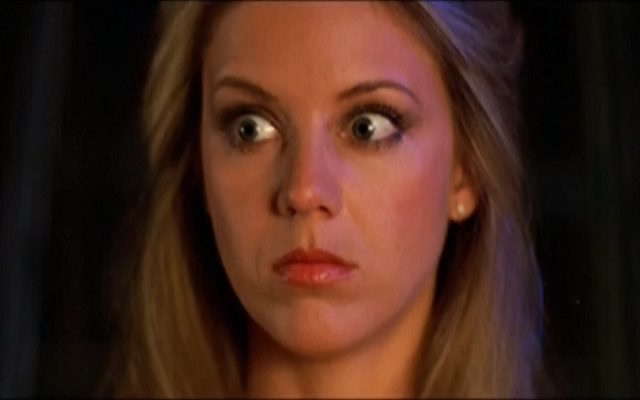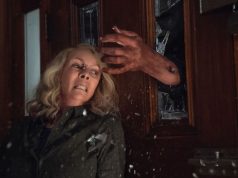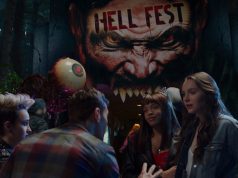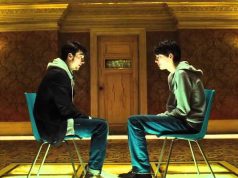
Many years ago, after Halloween introduced moviegoers to the pleasures of seeing horny young people stabbed to death by masked voyeurs, Hollywood was quick to meet the public’s sudden demand for derivative, uninspired ripoffs. And it wasn’t just Hollywood that answered the call. Even faraway lands such as Melbourne (often called the Hollywood of Victoria, Australia) responded with brainless, boob-full slasher flicks like Nightmares (also released as Stage Fright), which is the subject of today’s dissertation.
The opening credits say Nightmares is “from an original idea by John Lamond,” the film’s director, who mostly made sex comedies. I don’t know if “original” is the word I would use to describe this idea, though. I’m not even sure I would call it an “idea.” Whatever it is, it lacks basic narrative cohesion and features a central mystery whose solution is never less than obvious. What was Lamond’s “original idea”? To make a slasher movie with no scares or suspense? Sorry, but Friday the 13th beat you by a few months.
We begin in 1963. A woman drives a car while being fondled by her lover while her little girl, Cathy, sleeps in the backseat, because I guess it was Bring Your Daughter to Adultery Day. Cathy wakes up, is upset to see Mom whoring with a non-Dad person, tries to separate them, and causes a terrible accident. Mom is killed, her throat sliced by the windshield. Whoops! Everyone is very broken up about it.
Then it’s the present, i.e., 1980. For some reason Cathy is named Helen now, and she’s an emotionally unstable actress (but I repeat myself) trying to make it in Melbourne’s bustling theater district. She has recurring nightmares about slashed throats, and she shuns intimacy because she associates sex with her mother’s grisly death. So Helen is what they call “a real catch,” dating-wise. She gets cast in a play by a pretentious theater director (but I repeat myself) who hates the actors and the script. Her blandly appealing costar, Terry, tries to get a date with her, and she is alternately receptive or dismissive depending on how crazy she is that day.
Terry, a real sap, takes all the mercurial behavior Helen can throw at him. For example, one night after constantly rebuffing him, she shows up at Terry’s house saying she needs to talk to someone, climbs into bed with him, kisses him, then runs off again. Another time, Terry overhears her having a screaming argument with her dead mother, Norman Bates-style, but shrugs it off. Since he either doesn’t notice or doesn’t care that Helen is cuckoo-pants, Terry is a lot more surprised than we are when she kills him at the end of the movie.
But I’m getting ahead of myself. The murders start happening while the play is in rehearsals. It’s a small cast, though, and the movie has to pace itself, so the first victims are just a random randy couple doin’ it in the alley behind the theater. The killer slashes them up with a shard from a broken mirror, and let me just say I’m always glad when a slasher movie has actual slashing. The next victim is the stage manager, killed in exactly the same way the night before opening night (which should have been the dress rehearsal but WHATEVER, MOVIE).
All of the murders are presented in the genre-standard formula, with Killer-Cam point-of-view, heavy breathing, and gratuitous nudity on the part of the female victims. Now, the killer doesn’t say anything, and we never see his or her face. Usually that means the viewer isn’t supposed to know who it is … but it’s clearly Helen, right? It’s hilarious that Lamond plays it like a mystery. Not only does Helen have violent sexual hangups and a thing with broken glass, but after the alley couple are killed, her recurring nightmare starts featuring scenes from that murder. You know, because she did it. Yet even after this, the movie keeps the slasher’s face hidden from us till the very end, as if Lamond forgot he already told us who it was.
Anyway, the other actors in the play don’t know who killed the stage manager, and they are understandably distraught to arrive opening night and find her mangled corpse lying on the stage, hardly managing it at all. A few of the actresses blame Terry for bringing bad luck on them because he once whistled backstage, violating a dumb theater superstition (but I repeat myself). This is an actual concern for them, by the way. They gave him a really hard time about it when it happened, and now he is seriously on their poop list. They are very melodramatic about it. Actors, ladies and gentlemen! Actors.
Despite the cast’s emotional trauma and the theater being an active crime scene, the play is performed as scheduled. The director sits near the back of the house, and Bennett Collingswood, Melbourne’s bitchiest theater critic, stands behind him whispering taunts in his ear about how bad the play is (you know, like critics do). Though he hates theater in general and this play specifically, Collingswood, a bitter old queen with a gimpy leg, throws an opening-night party for the cast and crew at his lavish home, then tries to get one of the actors to sleep with him in exchange for a positive review. The actor storms off, and then “someone” (wink wink) stabs Collingswood to death with a shard of glass.
You get the feeling Lamond doesn’t like critics. Do you suppose he got some bad reviews in his day? I bet he did. What with making bad movies and all.
More cast and crew get bumped off the next night while Helen frets over whether these “dreams” she’s having are real. (THEY ARE REAL, THEY ARE CALLED MEMORIES.) I should mention that her flashbacks and nightmares sometimes include things that did not happen in this movie, suggesting the existence of deleted scenes. Further to that point, her relationship with Terry seems to skip a few steps, too, though that could just as easily be poor writing as sloppy editing. Or hey, why not both?
In the end, sure enough, it was Helen who killed everybody, just like Lamond told us it was before he forgot he told us. Just think, if this had become a franchise like Halloween or Friday the 13th, every sequel could have ended the same way, with the camera revealing that the killer was Helen again, like it was last time. That could have been the franchise’s “hook.” Fans would say, “I wonder how they’re going to reveal that Helen is the slasher at the end of this one??” and someone would rank all the “revelation that Helen is the slasher” scenes from best to worst. Alas, there were no sequels. And yet there are like 10 Saw movies. Whatever. It’s all politics.
— GeekNation





